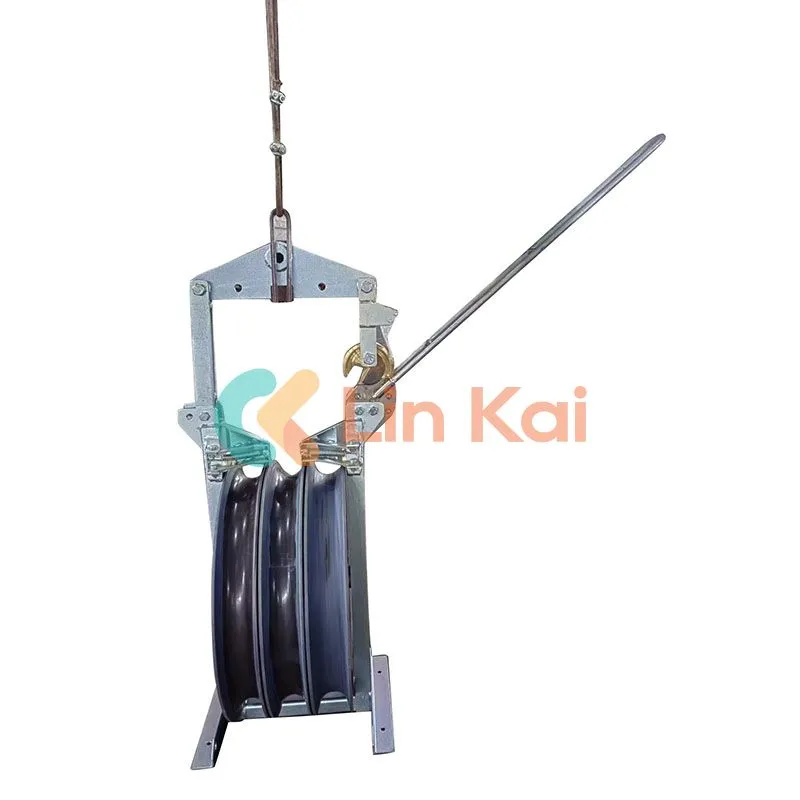How Stringing Blocks are Designed to Handle High-Tension Cables
2024-12-10
Stringing blocks, also known as cable rollers or pulling blocks, are critical components in overhead transmission and distribution line projects, particularly when high-tension cables are being installed. These blocks are designed to guide and support cables during the stringing process, ensuring that the cables do not suffer damage from excessive tension, friction, or misalignment. Let’s explore how stringing blocks are designed to effectively handle high-tension cables.

1. Material Strength and Durability
Stringing blocks are made from robust materials that can withstand the extreme forces exerted during the cable installation process:
- Steel or Aluminum Construction: Most stringing blocks are constructed from high-strength steel or aluminum alloys, which provide the necessary strength and durability to handle the significant weight and tension of high-voltage cables.
- Reinforced Design: In some cases, the blocks are reinforced with additional materials or structural elements to enhance load-bearing capacity and prevent deformation under high tension.
2. Roller System to Minimize Friction
One of the main functions of stringing blocks is to reduce friction as the cable is pulled through. This is crucial for preventing cable wear, heat generation, and damage to the conductor.
- Smooth, Curved Rollers: The rollers are typically designed with a smooth, rounded surface to minimize friction while allowing the cable to slide easily through the block. The curvature of the rollers ensures that the cable is guided smoothly, without sharp edges that could cause stress points.
- Material of Rollers: High-density materials such as nylon, UHMW (Ultra High Molecular Weight) polyethylene, or composite materials are often used for the rollers because they offer excellent wear resistance and low friction, while also being lightweight.
3. Load-Bearing Capacity
Stringing blocks must be able to handle the heavy loads generated by high-tension cables. The design ensures that the blocks can bear the weight of the cables, as well as any additional forces from pulling and tensioning.
- Heavy-Duty Bearings: Bearings inside the stringing blocks are designed to handle high radial loads and prevent mechanical failure. These bearings allow the rollers to rotate smoothly, reducing wear and tear on both the cable and the block.
- High Load Ratings: Stringing blocks are rated for specific load limits based on the size and type of cable being strung. For high-tension cables, the blocks are designed to handle loads of several tons, ensuring that the structure remains intact during the cable installation process.
4. Adjustable Features for Versatility
To accommodate different cable sizes and installation conditions, stringing blocks are designed with adjustable features:
- Variable Roller Sizes: Some blocks feature rollers that can be changed out or adjusted to fit different diameters of cables. This flexibility ensures that stringing blocks can handle both large, high-tension cables and smaller, more flexible conductors.
- Adjustable Angles: The blocks may also feature adjustable angles or tensioners, which help to guide the cable along the correct path and adjust the load distribution as needed.
5. Weather-Resistant Design
Since stringing blocks are used in outdoor environments, they must be designed to withstand harsh weather conditions, including rain, snow, extreme temperatures, and UV exposure.
- Corrosion-Resistant Coatings: Many stringing blocks are coated with corrosion-resistant materials such as galvanized steel or powder-coated finishes. This helps prevent rust and deterioration caused by environmental exposure.
- UV-Resistant Materials: The rollers and other components may be made from materials that are resistant to UV degradation, ensuring the blocks maintain their strength and functionality over time.
6. Safety Features
Stringing high-tension cables can be a dangerous operation, and stringing blocks are designed with safety in mind to ensure both the cable and workers are protected during installation.
- Cable Retention Mechanisms: Some stringing blocks include retention features that prevent the cable from slipping or falling out of the block during the pulling process. These can include locking mechanisms or a fixed, enclosed groove around the roller that securely holds the cable in place.
- Shock Absorption: In certain designs, shock-absorbing features or built-in dampeners are included to absorb sudden jolts or shocks that could damage the cable or the block during installation.
7. Customization for Specific Applications
Different types of high-tension cables—such as steel-reinforced cables, aluminum conductors, or optical ground wires—may require specific stringing block designs. Manufacturers offer a variety of configurations tailored to different installation scenarios:
- Heavy-Duty Blocks: For large-scale projects or cables with extreme tension, heavy-duty stringing blocks with reinforced structures and additional features may be required.
- Specialized Blocks for Dual or Multiple Cables: Some stringing blocks are designed to handle more than one cable at a time, particularly when laying cables in parallel configurations, such as for multi-circuit transmission lines.
Conclusion
Stringing blocks are specifically engineered to handle the high tensions and stresses associated with cable stringing. Their robust construction, smooth roller systems, load-bearing capabilities, and safety features all ensure that high-tension cables can be installed efficiently without damage. With advancements in materials and design, stringing blocks continue to evolve, making the process of installing overhead transmission lines safer, faster, and more reliable.


